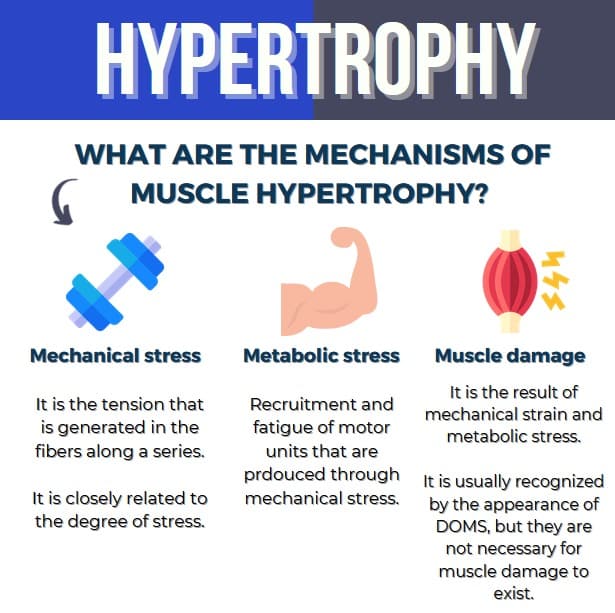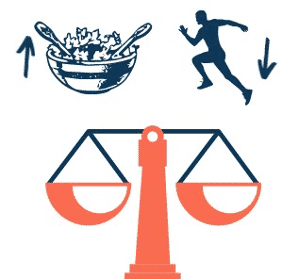29 de May de 2021
How to train to gain muscle mass?
Muscle mass gain and strength gain are one of the most sought-after qualities by those who want to see the best physique, achieve better marks in their respective sports modalities or improve their health. You may have tried different types of workouts, but you haven’t noticed any muscle mass gains. In this article we will give you the fundamental keys to let you know what you are failing at and manage to train to increase muscle mass.
Before we begin, I want you to understand that the fundamental pillars are training, nutrition and rest. If one of them fails, you will most likely hurt your potential performance.
What is muscular hypertrophy?
Muscle hypertrophy is an increase in muscle tissue size. Muscle grows by adding sarcomers (serial or parallel), increasing non-con retractable elements and sarcoplasmatic fluid and increasing satellite cell activity.
What are the mechanisms of muscular hypertrophy?
- Mechanical stress : This is mainly determined by intensity (weight) and working time (series duration).
- Metabolic stress : Depends on the anaerobic system and the aerobic intensity of the session, for example, performing circuits or super series, decreasing the pH level and causing the degradation of muscle fiber (Schoenfeld B., 2011).
- Muscle damage : Strength training creates a tension that exceeds the functional limits of muscle fiber, causing muscle damage (agujetas) and an inflammatory response, which enhances the release of various growth factors to promote recovery.

Figure 1. @rubrs_go
Train strenght, yes or yes.
Strength training is certainly imperative if our goal is muscle mass gain. We must understand certain fundamental concepts:
VOLUME, FREQUENCY AND INTENSITY
Volume: Total number of series per muscle group per week (or per session).
There is a dose-response relationship between volume and hypertrophy, so as we perform more volume, the more muscle mass increases.
This is so to some extent, from which, not to domore, we will hypertrophy more. Therefore, it seems that there is a maximum volume per session that can be effective in our workouts. If we get over it, we can even achieve a worse performance.
Because of this, to reach high volumes, we will have to increase the training frequency. There are individual differences in response to training volume, so the guides provided by the evidence should be considered, but then each subject must be adapted.
We can mark as maintenance volume 6 series /muscle group per week. As an effective minimum volume 8 series/muscle group per week and as maximum recoverable volume 20 series/muscle group per week.
Frequency: Can be defined as the number of times a given muscle group is exercised in a training week (7 days). Frequency does not appear to hypertrophy independently or at least not significantly.
In this case, frequency can be a tool for distributing the volume. Try not to over-volume in the same session (maximum 6-16 series/muscle group/session)
Intensity: is the corresponding to the proximity to muscle failure; that moment during a series in which the assesare not able to lift the weight during theconcentric phase of the lift. The closer we get to muscle failure, the greater the intensity of the series.
Training muscle failure does not seem to be essential to increase muscle size, although it also does not harm hypertrophy; more evidence is needed to be able to give more accurate recommendations.
As for the intensity of the load, which we can define as the % of the 1RM used in a given exercise, we need to know that hypertrophy is similar regardless of whether light loads (>15RM), moderate (9-15RM) or heavy (≤8RM) are used, provided that it is trained with a maximum stress character.
It’s also important that you’re present and secure in your workouts. There are two types of attentional spotlights:
- Internal focus: think about body movements when performing an activity.
For example. Contract the target muscle during an exercise.
- External focus– Display the target during execution, e.g. Move the load at maximum speed.
In several studies such as Benjamin J Snyder’s,he demonstrates the importance of attentional focus and better muscle activation when focused on the muscle involved. Verbal instruction such as indicating that certain muscles should also be contracted improve their activation.
As for the order of exercises, large muscle groups should always go before, i.e. exercises that give you a higher effort, which are usually multiarticular exercises. In this way, you can perform the exercises at a considerable intensity and high, raising the load that you can lift and thus improving the character of the effort. Afterwards, you’ll be able to focus on smaller muscle groups with monoarticular exercises.
Nutrition
Proper feeding is another of the most important pillars to consider if your goal is to increase our muscle mass. After a hard training session, the body needs to recover spent energy and muscles need to recover damaged tissues through feeding.
Calorie surplus: If you want to gain muscle mass it is essential to find yourself in a caloric surplus, but what is that?
Imagine a balance, on one side we find the Kcals we spend through our metabolism, our daily activity and our workouts. On the other hand, there are the Kcal that we ingest through the feed. In the event that we want to gain muscle mass, the balance must be tilted to the side of the intake, that is, we must consume more calories than we spend throughout the day.

Figure 2. @Rubrs_go Infographic
It is very important to make this surplus in a controlled way since, although it is normal to raise some fat mass, if we do not carry out a control we can pass and end up with a higher fat % than we should.
Another key factor in food is that the foods you eat are largely made up of real food,i.e. healthy foods, avoiding as much as possible ultra-processed, pre-cooked food or very caloric beverages such as high-volume beverages.
For example, healthy fats such as avocados, extra virgin olive oil or nuts.
For proteins, try to reach the recommended minimum intake with alimentos such as eggs, soybeans, legumes or animal proteins.
As for carbohydrates, they are the ones that will give you enough energy to face our workouts, rice, pasta, potatoes or sweet potatoes among others are very good choice. If we want the absorption of these foods to be faster, we should look at the glycemic index, since the higher it is, the faster we can get the glucose
These are general patterns, but I must insist on the need for personnel to feed. A 25-year-old woman weighing 45kg shouldn’t feed he like a 36-year-old man who weighs 87kg. The amount of macro and micronutrients will be different
Supplements
- Creatine: is a natural compound formed by 3 amino acids: methionine, arginine and glycine. The body can get to synthesize in foolish to 1g, the remaining amount should be included by feeding and/or supplementation.
Creatine helps to increase muscle mass indirectly because having more energy in workouts will make them of higher quality, lifting heavier loads and generating greater muscle adaptations.
There are numerous myths around creatine, but quiet, numerous studies have shown that it is not dangerous or produces alopecia. It is a supplement with great scientific support and with very interesting benefits.
- Protein powder: Protein shakes are just that, protein like any other you can eat in your day today. Think for example of eggs, legumes, milk, etc. And that’s effectively where protein shakes come from.
There are different types, but the vast majority are made through whey which is then filtered to be powdered. In this way its conservation is simpler and more practical. Although there are also plant proteins such as pea protein.
As we can see in this study by Philippe J M Pinckaers and collaborators, the amount of daily protein ingested than the sources of this one is more decisive.
The optimal dose of protein varies greatly depending on the person, but according to scientific evidence there are approximate ranges that can serve as a reference. If we are in a caloric surplus, it is recommended between 1.4-2g /kg/day.
Remember that supplementation is not going to make you gain muscle mass in itself, it will only be a small help if you do not manage to reach the requirements through real food intake.
Rest, that big forgotten.
Undoubtedly, on many occasions the great forgotten. Rest, as well as training and nutrition is essential when it comes to gaining muscle mass.
Sleep is probably the most basic and important form of passive recovery that the athlete can adopt. There is important scientific evidence of the many benefits that exist for recovery in the sports field from having a good night’s rest. Athletes, due to their high energy demand, must understand the importance of adequate rest in performance, recovery and competition.
In adults, recommendations range from 7 to 9 hours of sleep per night, where health, wellness and performance can be compromised if reduced. In athletes a greater need for sleep has been suggested to allow adequate recovery and adaptation between exercise sessions, establishing this between 9-10 hours of sleep.
If you want to know more techniques or strategies to recover you can look at this article on our blog: https://vitruve.atomic4dev.net/blog/recovery-strategies-and-techniques-for-athletes/
Bibliography
- Schoenfeld B. (2021). Science and Development of Muscle Hypertrophy. Second edition. Human Kinetics
- Schoenfeld, B. J., Ogborn, D.I., & Krieger, J. W. (2015). Effect of repetition duration during resistance training on muscle hypertrophy: a systematic review and meta-analysis. Sports medicine (Auckland, N.Z.), 45(4), 577–585. https://doi.org/10.1007/s40279-015-0304-
- Schoenfeld, B. J., Grgic, J., Van Every, D. W., & Plotkin, D. L. (2021). Loading
- Recommendations for Muscle Strength, Hypertrophy, and Local Endurance: A Re-Examination of the Repetition Continuum. Sports (Basel, Switzerland),9(2), 32. https://doi.org/10.3390/sports9020032
- Krieger, J. Training Frequency for Hypertrophy: The Evidence-Based Bible. Weightology.2019.

